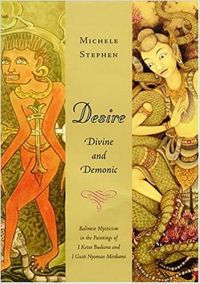Desire: Divine and Demonic
- Title
- Desire: Divine and Demonic
- Original language
- English
- Author(s)
- Illustrator(s)
- Publisher
- University of Hawaii Press
- ISBN
- 978-0824828592
- Publication date
- 2005
- Subjects
- Art
- religion
- Find Book
- Amazon
- Related Env. Initiatives
- Related Places
- Related Biographies
- Related Children's Books
- Related Holidays
- Related Folktales
- Related Comics
- Related Lontar
- Linked words
Description(s)
This original and innovative book challenges many of our long-held assumptions about traditional Balinese religion. Drawing on data from visual art, mythology, esoteric texts, and public rituals, Michele Stephen identifies a core of important mystical themes at the heart of Balinese religion and demonstrates the striking parallels between these and Indian Tantric thought. She argues that Balinese cosmology can be better understood in terms of transformations, ambivalence, and dynamic cycles of desire and destruction rather than the fixed hierarchies, harmonies, and balance that have dominated previous accounts. Far from being primarily a matter of customary forms and public ritual, the author shows that Balinese religion also encompasses important streams of mystical thought, including the inner spiritual discipline of various yogic teachings. Desire, Divine and Demonic begins with an introduction to the problems of defining mysticism in Bali, a discussion of prevailing scholarly views concerning the nature of Balinese religion, and a brief description of the link between art and religion in Balinese culture. What follows is an intriguing analysis of two series of paintings by contemporary Balinese artists I Ketut Budiana and I Gusti Nyoman Mirdiana, who specialize in mystical and mythological scenes. These paintings, in Stephen's convincing interpretations, illustrate important mystical themes--themes that also appear in oral and textual versions of Balinese myths and philosophical texts and bear remarkable similarity to the basic premises of Indian Tantric thought. In the book's final chapter, Stephen examines several well-known Balinese rituals to show how they can be reinterpreted as expressions of the central and classic themes of Shivaitic Tantric philosophy.







Enable comment auto-refresher